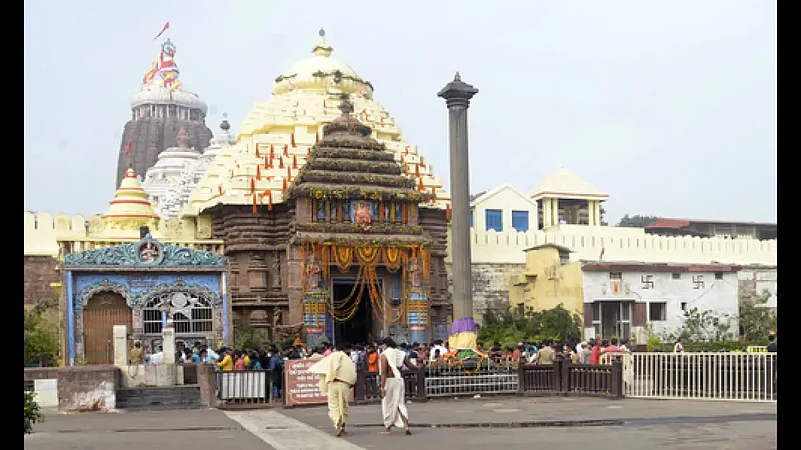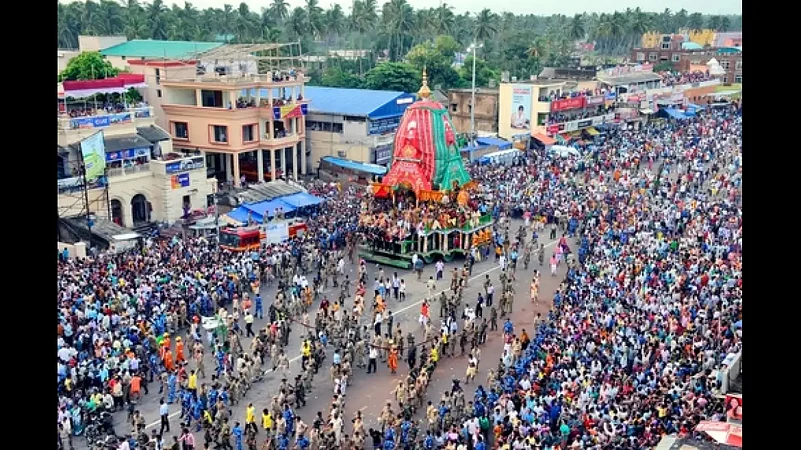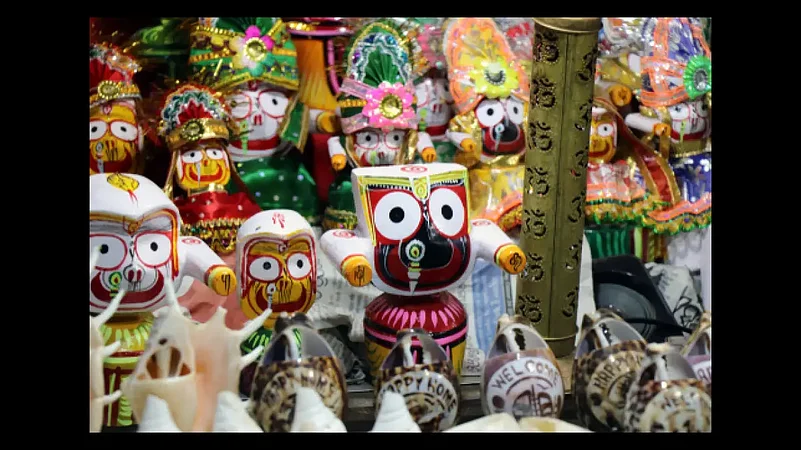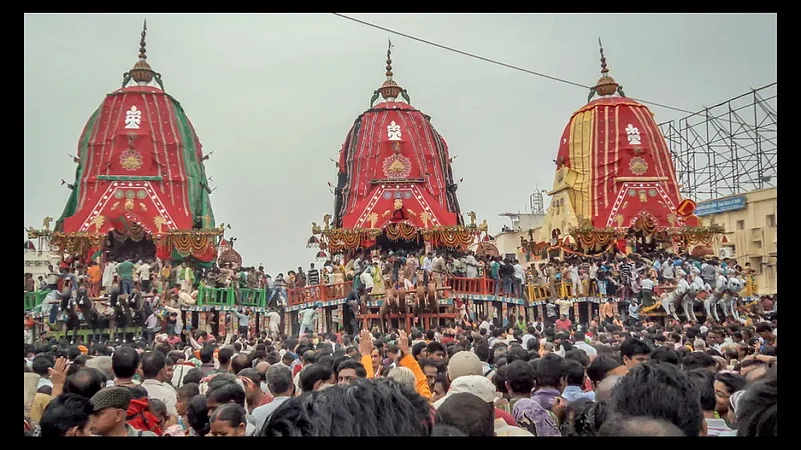A loud cheer went up from the crowd, which was swelling by the minute, as the servitors appeared at the doorstep of the temple with the huge wooden idol of Lord Jagannath. As if carrying the huge, heavy idol from the temple to the chariot was not an ordeal in itself, hundreds of people lunged at the idol to touch it or tear off a piece of the floral headgear as souvenir. I was in Puri, Odisha’s famous beach town, to attend the annual Rathayatra festival or the grand chariot festival.
Siblings Balabhadra (elder brother) and Subhadra (younger sister) were already seated on their respective chariots. Now it was the turn of Jagannath (the Lord of the Universe). The servitors had a hard time pulling and pushing the idols up a ramp to seat them in the chariots which were beautifully decorated with miniature wooden figurines and draped in cloth showcasing the applique art of Pipili, a village near Puri.
Each chariot could be distinguished by their various features. The chariot of Balabhadra, known as Taladwaja, was 44 feet high, draped in red and green cloth, and rolled on 14 wheels. Subhadra’s chariot was called Darpadalan, 43 feet, covered in red and black cloth and ran on 12 wheels. Jagananth’s chariot was known as Nandighosh; covered in red and yellow cloth, it was 45 feet high and had 16 wheels. Mesmerised by the sight of this grand chariot, rolling on its massive wheels, pulled by the pilgrims, the British had coined the word ‘juggernaut’ meaning ‘unstoppable power’.
The three chariots are built anew every year. On the eve of the festival, the chariots were lined up next to the Arun Stambha in front of the Singha Dwar (Lion Gate) of the temple, and coils of stout ropes tied to the axles.
Around me, the crowd was like a river in spate. Pilgrims surged ahead, their hands thrown to the sky and chanting the Lord’s name, members of the local Vaishnav mutts sang kirtans, costumed Odissi dancers and acrobats gave impromptu performances. In between, photographers, Indians and foreigners, dodged through the crowd, rushing everywhere for that ‘wow’ shot. Suddenly, there was a shout and the crowd parted just a wee bit to allow the civic volunteers to carry away an old lady who had fainted. The humidity was killing and the fire brigade sprayed the crowd with jets of cold water every now and then. But what surprised me was that despite the crowd, there was no jostling, no pushing over.
There are two ways to see the festival. Either you play it safe – buy a ticket for a seat in the galleries constructed near the starting point of the chariots’ journey. Or, simply lose yourself in the sea of people travelling along the Bada Danda, the Grand Road, in front of the 12th century temple, down which the three chariots will trundle as the gods travel to their aunt’s house, the Gundicha Temple. I chose the latter.
The genesis of the cult of Jagannath is rooted in legends. Apparently, Vidyapati, a Brahmin priest was dispatched by King Indradyumna of Malwa to locate the idol of Nilmadhav which was being worshipped in secret by Viswabasu, a chieftain of the Shabar tribe. Vidyapati, who ended up marrying the daughter of the chieftain, was finally able to locate the idol. However, the idol disappeared by itself. King Indradyumna received divine instructions that a new idol be made from wood. Since then, Lord Jagannath and his siblings are being worshipped in Puri, which is also known as the Shree-kshetra.

The towering idols are worshipped inside the temple and brought out during the Snanyatra which precedes the chariot festival by 15 days. It is said that the idols go into convalescence soon after the bath and retire to a special chamber. This phase is known as ‘anabasara’, and pilgrims cannot catch a glimpse of the idols until the start of the chariot festival. Just before the chariot festival, the idols are repainted. In the olden days, local artists would paint ‘patachitra’ of the three idols and sell them to the pilgrims who came to Puri during this period.
Interestingly, when the three idols reside in the temple, they are worshipped by Brahmin priests. But once they leave the temple for the 10-day long Rathayatra festival, the rituals are performed by a class of non-Brahmin servitors called Daitapatis, who claim to be descendants of the Shabar king.
There are innumerable rituals associated with Rathayatra. But one ritual that draws the most attention is the Chhera Pahanra, a lesson in humility. Based on the concept that everyone is equal in the eyes of god, the Gajapati ruler of Puri sweeps the three chariots with a golden broom before they can set out on their journey.
Now the pilgrims were waiting eagerly to pull the ropes, taking the chariots on their three km long journey. The rituals over, the first chariot to commence the journey was Taladhvaja, followed by Darapdalan. Finally, it was the turn of Nandighosh.

I had read and heard about the cult of Jagannath and the frenzy of the Rathayatra. But still I was taken aback by what I saw. It was like the eruption of mass euphoria as the signal to begin pulling the chariot of Jagannath was given. Cries of Jai Jagananth rent the air as the crowd took up the long stout rope and began to pull. And the wheels of the giant chariot only creaked in response. Then as the people tugged with renewed energy, it began to trundle forward. And then there was no stopping. Knowing I would be no match to that swirling crowd, I decided to run alongside the chariot like many others who could not get a hand on to the ropes.
At the Gundicha Temple, the deities were taken inside the temple. The will stay here until the day of Bahuda Yatra, when it is time to return. There are many interesting anecdotes associated with the Rathayatra celebration. Such as Hera Panchami. As Jagannath is an incarnation of Vishnu, his wife is Lakshmi, who resides in the royal palace. Miffed by the fact that Jagannath was neglecting her and spending time at the aunt’s house, Lakshmi would creep up to his chariot and break a piece of the wheel. Even gods have human foibles.

The idols ride back to the temple on the eighth day of the festival. But they are not taken inside immediately. They are left on the chariots. The next day, the idols are adorned with gold ornaments. This is known as Sunabesh. The following day, after being served with Adharpana, a cooling drink, the idols are finally taken inside the temple; the return to the temple is known as Niladri Bije. As Jagannath is about to enter the temple, the doors are shut; apparently on the order of his wife, goddess Lakshmi. Priests from both sides carry on a conversation on the behalf of the deities. Finally, Lord Jagannath offers a pot of rasagola (rasgulla) to his wife as a mark of appeasement and is allowed to enter.
The Information
Bhubaneswar, 60km by road from Puri, is the nearest airport. By rail, Puri is linked with many cities in India, including Kolkata, New Delhi, Mumbai, etc. There are plenty of options in Puri. But most places are booked well in advance. On the day of Rathayatra, there are traffic restrictions in Puri. So be prepared to walk to and from the venue. It can be very hot and rainy; so carry drinking water, umbrella or rain-gear. You may combine a visit to Puri with the UNESCO World Heritage Site of Konark (knwon for its Sun Temple) and state capital Bhubaneswar, and Chilika Lake.
Last minute planners, check with Odisha Tourism Development Corporation for their Rathayatra Special packages from Bhubaneswar and Sambalpur.
















